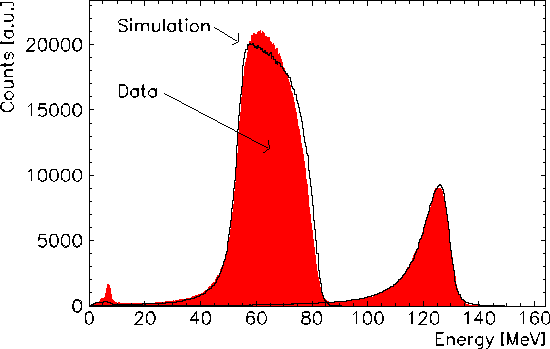





7.5.1 Simulation and Background Discussion
All of the steps concerning the cuts were included in the GEANT simulation. A
beam of negative pions with 40 MeV kinematical energy was impinging the liquid
hydrogen target after degradation. Having a nearly uniform beam profile of
about 1 cm diameter, the stopping distribution within the target was obtained
to be of Gaussian shape. The values for sigma amounted 0.86 cm, 0.74 cm and
0.92 cm in the x, y, and z direction, respectively. SCX or RC events were
initiated from within this stopping distribution. In addition, possible
background contributions due to pion interactions with matter were simulated.
The main purpose of this simulation was the evaluation of the fit functions and
the determination of the acceptance correction factor.
A target-empty run in a previous beam period did not lead to a notable count
rate. This was confirmed by simulation. The percentage of beam pions and beam
muons, as well, hitting the calorimeter either directly or after scattering
amounted to 8.4*10-3 %. After including plastic scintillator
hodoscope and timing cut, the contribution of beam particles to the final data
sample could be neglected.

Figure 7-12 Overlay of data and simulation. In contrast to the well-matched RC
peak, the SCX contribution could not be matched exactly by using the considered
sources contributing to the energy resolution. This difference is reflected in
the systematical error as described in the sections below.
The low energy background that is considered to be caused by bremsstrahlung of
positrons or electrons, generated by photon conversion at the target walls, is
disappearing thanks to the use of mylar windows in the target vessel. This is
proved by the tail of the fit function smoothly following the data (see Figure
7-15).



















